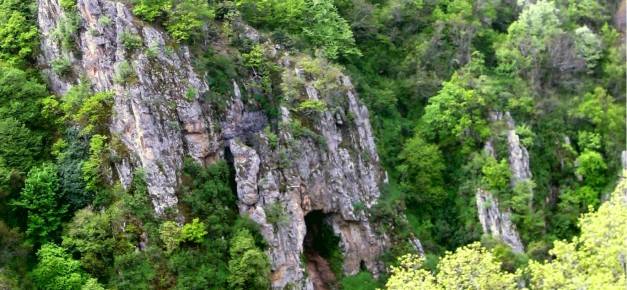Original version

At the foot of Orelyak peak (2099 m.) there are the Dragon rock (Zmeyova skala) and the cave - Dragon hole (Zmeyova dupka). The smaller cave is known as the cave of the winged horse of the Pirin dragon. The bigger cave is the home of the Dragon himself. Up in the ceiling there is an oval hole drilled, according to the legend,by the Belasitsa Dragon's Lightning.In Bulgarian folklore the dragon has a human body and a serpentine tail, covered with scales, he has golden wings. He is extremely powerful - with one blow he can take trees from their roots and raise them in the sky. He lives in caves on the high mountain peaks.
The legend tells that on Easter the Pirin Dragon grabbed from the horo the most beautiful maiden -Stana. He carried her under the village of Dragon’s hole and there he made her his bride. She was pregnant with his child, when the Pirin Dragon once laid under the spring sun on his bride's lap to take a nap. He ordered her if she sees a small cloud in the sky, to wake him up. The dragon’s bride saw the cloud, but she did nit want to awaken the dragon. Soon the cloud became big and stormy. She realized she made a mistake and tried to wake her husband, but he slept deeply. Finally she wept, a tear fell and woke him up. But it was too late. A beast came out of the cloud – the Belasitsa Dragon.
As the Pirin dragon went into the cave to take his mace, the Belasitsa dragon attacked him, pierced the cave from above - the home of the dragon - and killed him. The Dragon Bride became a widow. A shepherd boy found her. The shepherd boy told Stana’s father and he made stairs, took her from the cave and took her home. Not long after, a child was born – he was named Gincho. The child was unusually big, strong and with wings. In three years he was so strong that he and his grandfather went to the mountains to pick up wood. He once told his grandfather that he wanted him to go to Serres to the market and buy him tallow to make balls. The grandfather did it for his grandson.
Then the child told his grandfather that he had to fight the dragon who had killed his father and settled in the lake on the summit of the Pirin mountain to the peak of Orelyak. The grandfather was frightened and advised the boy not to fight the dragon because he was very strong. The child, however, was impossible to divert from his decision. He told his grandfather to go with him to the lake and if he saw a blue flame over the water to throw a tallow ball. If he saw a white flame coming - to throw nothing. The grandfather did this. Eventually the dragon child came out of the water carrying the heart of his father's murderer. Together with the defeated dragon the water from the lake disappeared. Thus appeared the area "Dry Lake", south of Orelyak Peak.
The young Pirin dragon stayed there on the top of the mountain. He settled on the Chaushka Rock and, according to the local folk beliefs, still preserves the land of the village of Pirin. A little cloud can be seen around the top even in clear weather. Against the duty of a guardian of the countryside, the dragon chooses the best girls from the village for his brides. They were all of the Gincho’s family. When he was doing his house he brought and laid the huge stone blocks, weighing at least half a ton, which lie at the base and can be seen today. The house itself is in poor condition, but in overall it is still preserved.

